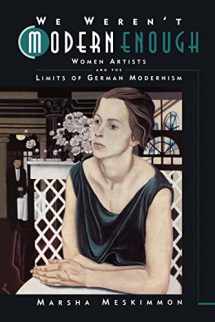
We Weren't Modern Enough: Women Artists and the Limits of German Modernism (Weimar and Now: German Cultural Criticism, No. 25)
ISBN-13:
9780520221345
ISBN-10:
0520221346
Edition:
First Edition
Author:
Marsha Meskimmon
Publication date:
1999
Publisher:
University of California Press
Format:
Paperback
272 pages
Category:
Criticism
,
Arts History & Criticism
,
History
,
Women's Studies
FREE US shipping
Book details
ISBN-13:
9780520221345
ISBN-10:
0520221346
Edition:
First Edition
Author:
Marsha Meskimmon
Publication date:
1999
Publisher:
University of California Press
Format:
Paperback
272 pages
Category:
Criticism
,
Arts History & Criticism
,
History
,
Women's Studies
Summary
We Weren't Modern Enough: Women Artists and the Limits of German Modernism (Weimar and Now: German Cultural Criticism, No. 25) (ISBN-13: 9780520221345 and ISBN-10: 0520221346), written by authors
Marsha Meskimmon, was published by University of California Press in 1999.
With an overall rating of 4.2 stars, it's a notable title among other
Criticism
(Arts History & Criticism, History, Women's Studies) books. You can easily purchase or rent We Weren't Modern Enough: Women Artists and the Limits of German Modernism (Weimar and Now: German Cultural Criticism, No. 25) (Paperback) from BooksRun,
along with many other new and used
Criticism
books
and textbooks.
And, if you're looking to sell your copy, our current buyback offer is $0.58.
Description
Marsha Meskimmon furnishes a fresh perspective on the art of women in the Weimar Republic and in the process reclaims the lost history of a number of artists who have not received adequate attention—not only because they were women but also because they continued to align themselves with the modes of realistic representation the Expressionists regarded as reactionary. Reconsidering the traditional definitions of German modernism and its central issues of race politics, eugenics, and the city, Meskimmon explores the structures that marginalized the work of little known artists such as Lotte Laserstein, Jeanne Mammen, Gerta Overbeck and Grete Jurgens. She shows how these women's personal and professional experiences in the 1920s and 1930s relate to the visual imagery produced at that time. She also examines representations of different female roles—prostitute, mother, housewife, the "New Woman" and "garçonne"—that attracted the attention of these artists. Situating her exploration on a strong theoretical base, she ranges deftly over mass visual culture—from film to poster art and advertising—to create a vivid portrait of women living and creating in Weimar Germany.


We would LOVE it if you could help us and other readers by reviewing the book
Book review

Congratulations! We have received your book review.
{user}
{createdAt}
by {truncated_author}


